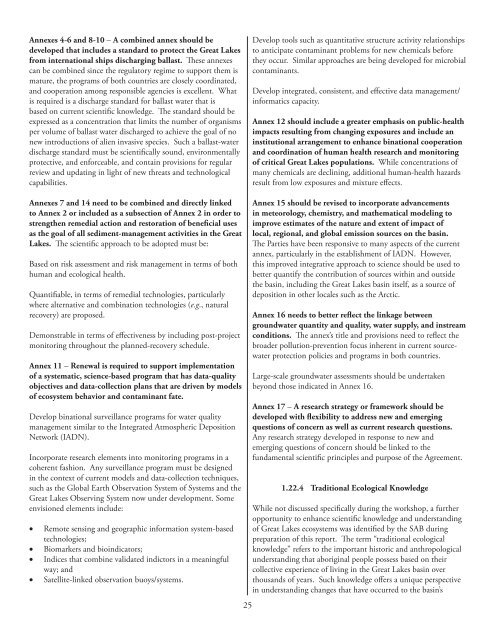Principles for Review of the Great Lakes Water Quality Agreement
Principles for Review of the Great Lakes Water Quality Agreement
Principles for Review of the Great Lakes Water Quality Agreement
You also want an ePaper? Increase the reach of your titles
YUMPU automatically turns print PDFs into web optimized ePapers that Google loves.
Annexes 4-6 and 8-10 – A combined annex should be<br />
developed that includes a standard to protect <strong>the</strong> <strong>Great</strong> <strong>Lakes</strong><br />
from international ships discharging ballast. These annexes<br />
can be combined since <strong>the</strong> regulatory regime to support <strong>the</strong>m is<br />
mature, <strong>the</strong> programs <strong>of</strong> both countries are closely coordinated,<br />
and cooperation among responsible agencies is excellent. What<br />
is required is a discharge standard <strong>for</strong> ballast water that is<br />
based on current scientific knowledge. The standard should be<br />
expressed as a concentration that limits <strong>the</strong> number <strong>of</strong> organisms<br />
per volume <strong>of</strong> ballast water discharged to achieve <strong>the</strong> goal <strong>of</strong> no<br />
new introductions <strong>of</strong> alien invasive species. Such a ballast-water<br />
discharge standard must be scientifically sound, environmentally<br />
protective, and en<strong>for</strong>ceable, and contain provisions <strong>for</strong> regular<br />
review and updating in light <strong>of</strong> new threats and technological<br />
capabilities.<br />
Develop tools such as quantitative structure activity relationships<br />
to anticipate contaminant problems <strong>for</strong> new chemicals be<strong>for</strong>e<br />
<strong>the</strong>y occur. Similar approaches are being developed <strong>for</strong> microbial<br />
contaminants.<br />
Develop integrated, consistent, and effective data management/<br />
in<strong>for</strong>matics capacity.<br />
Annex 12 should include a greater emphasis on public-health<br />
impacts resulting from changing exposures and include an<br />
institutional arrangement to enhance binational cooperation<br />
and coordination <strong>of</strong> human health research and monitoring<br />
<strong>of</strong> critical <strong>Great</strong> <strong>Lakes</strong> populations. While concentrations <strong>of</strong><br />
many chemicals are declining, additional human-health hazards<br />
result from low exposures and mixture effects.<br />
Annexes 7 and 14 need to be combined and directly linked<br />
to Annex 2 or included as a subsection <strong>of</strong> Annex 2 in order to<br />
streng<strong>the</strong>n remedial action and restoration <strong>of</strong> beneficial uses<br />
as <strong>the</strong> goal <strong>of</strong> all sediment-management activities in <strong>the</strong> <strong>Great</strong><br />
<strong>Lakes</strong>. The scientific approach to be adopted must be:<br />
Based on risk assessment and risk management in terms <strong>of</strong> both<br />
human and ecological health.<br />
Quantifiable, in terms <strong>of</strong> remedial technologies, particularly<br />
where alternative and combination technologies (e.g., natural<br />
recovery) are proposed.<br />
Demonstrable in terms <strong>of</strong> effectiveness by including post-project<br />
monitoring throughout <strong>the</strong> planned-recovery schedule.<br />
Annex 11 – Renewal is required to support implementation<br />
<strong>of</strong> a systematic, science-based program that has data-quality<br />
objectives and data-collection plans that are driven by models<br />
<strong>of</strong> ecosystem behavior and contaminant fate.<br />
Develop binational surveillance programs <strong>for</strong> water quality<br />
management similar to <strong>the</strong> Integrated Atmospheric Deposition<br />
Network (IADN).<br />
Incorporate research elements into monitoring programs in a<br />
coherent fashion. Any surveillance program must be designed<br />
in <strong>the</strong> context <strong>of</strong> current models and data-collection techniques,<br />
such as <strong>the</strong> Global Earth Observation System <strong>of</strong> Systems and <strong>the</strong><br />
<strong>Great</strong> <strong>Lakes</strong> Observing System now under development. Some<br />
envisioned elements include:<br />
• Remote sensing and geographic in<strong>for</strong>mation system-based<br />
technologies;<br />
• Biomarkers and bioindicators;<br />
• Indices that combine validated indictors in a meaningful<br />
way; and<br />
• Satellite-linked observation buoys/systems.<br />
25<br />
Annex 15 should be revised to incorporate advancements<br />
in meteorology, chemistry, and ma<strong>the</strong>matical modeling to<br />
improve estimates <strong>of</strong> <strong>the</strong> nature and extent <strong>of</strong> impact <strong>of</strong><br />
local, regional, and global emission sources on <strong>the</strong> basin.<br />
The Parties have been responsive to many aspects <strong>of</strong> <strong>the</strong> current<br />
annex, particularly in <strong>the</strong> establishment <strong>of</strong> IADN. However,<br />
this improved integrative approach to science should be used to<br />
better quantify <strong>the</strong> contribution <strong>of</strong> sources within and outside<br />
<strong>the</strong> basin, including <strong>the</strong> <strong>Great</strong> <strong>Lakes</strong> basin itself, as a source <strong>of</strong><br />
deposition in o<strong>the</strong>r locales such as <strong>the</strong> Arctic.<br />
Annex 16 needs to better reflect <strong>the</strong> linkage between<br />
groundwater quantity and quality, water supply, and instream<br />
conditions. The annex’s title and provisions need to reflect <strong>the</strong><br />
broader pollution-prevention focus inherent in current sourcewater<br />
protection policies and programs in both countries.<br />
Large-scale groundwater assessments should be undertaken<br />
beyond those indicated in Annex 16.<br />
Annex 17 – A research strategy or framework should be<br />
developed with flexibility to address new and emerging<br />
questions <strong>of</strong> concern as well as current research questions.<br />
Any research strategy developed in response to new and<br />
emerging questions <strong>of</strong> concern should be linked to <strong>the</strong><br />
fundamental scientific principles and purpose <strong>of</strong> <strong>the</strong> <strong>Agreement</strong>.<br />
1.22.4 Traditional Ecological Knowledge<br />
While not discussed specifically during <strong>the</strong> workshop, a fur<strong>the</strong>r<br />
opportunity to enhance scientific knowledge and understanding<br />
<strong>of</strong> <strong>Great</strong> <strong>Lakes</strong> ecosystems was identified by <strong>the</strong> SAB during<br />
preparation <strong>of</strong> this report. The term “traditional ecological<br />
knowledge” refers to <strong>the</strong> important historic and anthropological<br />
understanding that aboriginal people possess based on <strong>the</strong>ir<br />
collective experience <strong>of</strong> living in <strong>the</strong> <strong>Great</strong> <strong>Lakes</strong> basin over<br />
thousands <strong>of</strong> years. Such knowledge <strong>of</strong>fers a unique perspective<br />
in understanding changes that have occurred to <strong>the</strong> basin’s

















